Submissions: 2021 January
Re: Submissions: 2021 January
Jones-Emberson 1 (PK 164+31.1) is a planetary nebula in the constellation Lynx at a distance of 1600 light years. It is a larger planetary with low surface brightness. The 16.8-magnitude central star is a very blue white dwarf.
Click on above to enlarge.
Full details @ https://www.kinchastro.com/jones-emberson-1-2021.html
Click on above to enlarge.
Full details @ https://www.kinchastro.com/jones-emberson-1-2021.html
Re: Submissions: 2021 January
van den Bergh 14 and 15 are a pair of reflection nebula located in Camelopardalis, close to Sh2-202 (which is edging into the right hand side of the frame). vdB 15 (to the south) has an interesting pinkish/yellow component to it - it provides a real challenge in getting both the colour and saturation correct. Additionally, a very rich star field complements the field but makes it hard to prevent it overwhelming the nebulae.
By adding H-Alpha data into the mix, it enhances the regions of hydrogen emission that encroach on and faintly pervade the area: not far away to the west are the Heart and Soul - it's a very busy area of sky.
There is a tiny (almost stellar in nature at this scale!) planetary nebula, catalogued as Kohoutek 3-64, to the left of the frame, that shines like a small pink beacon in the light of H-alpha.
The brighter region of hydrogen emission to the bottom left of the image appears to be catalogued as IRAS 03306+5825/Lyder-Galt B03306+5825 - the HII region above vdB14 (and above left from Sh2-202) is catalogued as Lyder-Galt B03211+6018.
Data was captured Dec 2020/Jan 2021.
Image Capture: Paul Tribe & Graeme Coates
Processing: Graeme Coates

Astrobin link:

By adding H-Alpha data into the mix, it enhances the regions of hydrogen emission that encroach on and faintly pervade the area: not far away to the west are the Heart and Soul - it's a very busy area of sky.
There is a tiny (almost stellar in nature at this scale!) planetary nebula, catalogued as Kohoutek 3-64, to the left of the frame, that shines like a small pink beacon in the light of H-alpha.
The brighter region of hydrogen emission to the bottom left of the image appears to be catalogued as IRAS 03306+5825/Lyder-Galt B03306+5825 - the HII region above vdB14 (and above left from Sh2-202) is catalogued as Lyder-Galt B03211+6018.
Data was captured Dec 2020/Jan 2021.
Image Capture: Paul Tribe & Graeme Coates
Processing: Graeme Coates

Astrobin link:

Re: Submissions: 2021 January
A few fresh images...
PLEASE see the full resolution by choosing "original" under the image at my site - the images posted here a heavily downscaled!
Larger versions:
https://pbase.com/tango33/new_images
Thanks for looking!
Kfir Simon
NGC 3293 cluster:
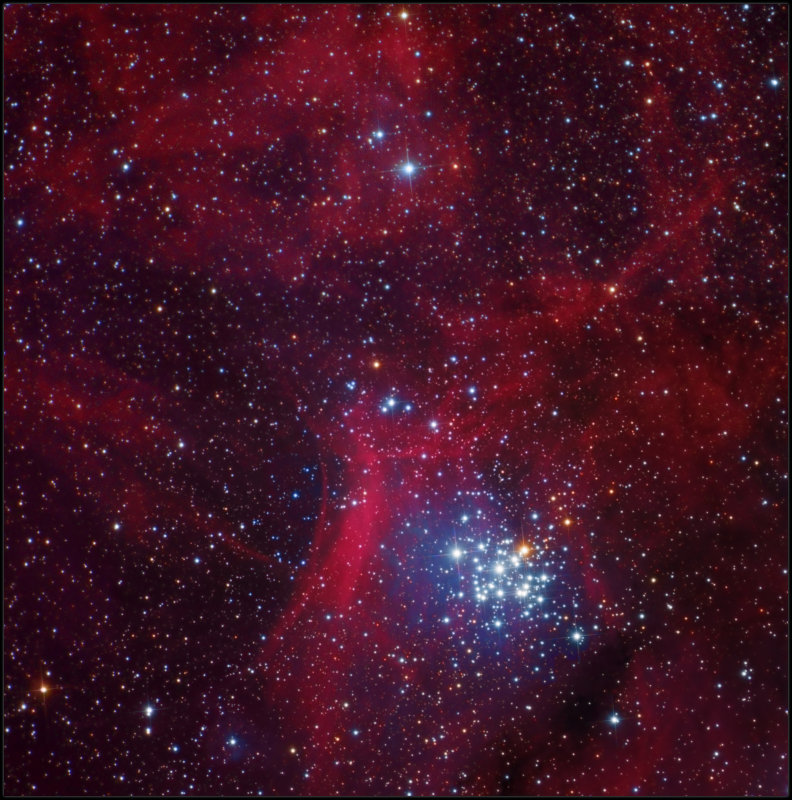
A closer look:
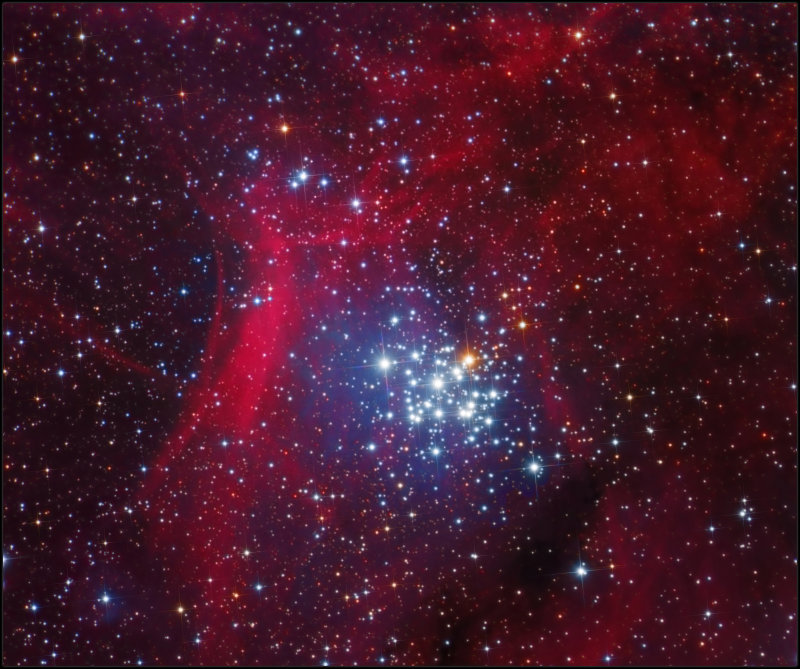
Barnard 30:

IC 2966 SNR:
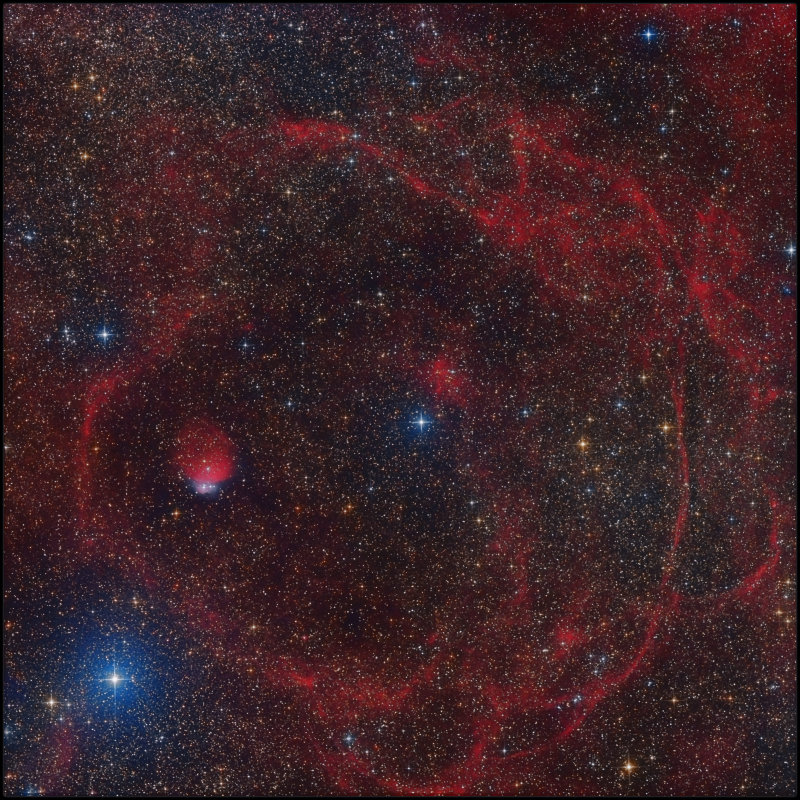
NGC 6744 galaxy:

PLEASE see the full resolution by choosing "original" under the image at my site - the images posted here a heavily downscaled!
Larger versions:
https://pbase.com/tango33/new_images
Thanks for looking!
Kfir Simon
NGC 3293 cluster:

A closer look:

Barnard 30:

IC 2966 SNR:

NGC 6744 galaxy:

-
strongmanmike
SH2-308 A cosmic bubble being blown in Canis Major
Sitting in a rich field of OIII and Halpha emission nebulae, a remarkable and beautiful, striated, teal coloured, almost perfectly spherical, bubble, is being blown in the interstellar medium by the intense stellar wind from a very hot and massive Wolf-Rayet star at its centre. Wolf-Rayet stars have surface temperatures of between 30 000K and 210 000 K, compared to our Sun, which has a surface temperature of just 5800K!
A larger image can be seen here: https://www.flickr.com/photos/strongman ... ateposted/ (click on image to enlarge and pan around with your cursor)
Copyright: Michael Sidonio 2020
A larger image can be seen here: https://www.flickr.com/photos/strongman ... ateposted/ (click on image to enlarge and pan around with your cursor)
Copyright: Michael Sidonio 2020
-
andrystix
Re: Submissions: 2021 January
 Torre De Barnard by Andrea Amici - Andrystix
Torre De Barnard by Andrea Amici - AndrystixTorre De Barnard
Here is the Tower of Portonovo, a pearl in the Adriatic Sea.
I allowed myself to melt the beautiful molecolar cluster of Orion with the beautiful park of Conero. (19/1/21 9pm)
two panel merged with PS:
top -> 19 shoots tracked with iOptron Sky Guider Pro (stacked with Sequator)
bottom - > single shoot for the ground
each shoot has the same setting: 40s, ISO800, f/4
Nikon D750 (modded), AF-S NIKKOR 20mm f/1.8G ED, iOptron Skyguider Pro.
SOCIAL: @andrystix on Instagram, Facebook and Flickr.
-
Star_Digger
- Ensign
- Posts: 21
- Joined: Thu Jul 27, 2017 11:25 am
Re: Submissions: 2021 January
Last edited by bystander on Thu Jan 21, 2021 7:54 pm, edited 1 time in total.
Reason: All <img> tags require an image url not a page url.
Reason: All <img> tags require an image url not a page url.
-
cariletelier
- Asternaut
- Posts: 3
- Joined: Mon Jul 20, 2020 2:18 pm
Re: Submissions: 2021 January
The meeting: Orion, Scorpius and Rukapillan
Place: Villarrica volcano, La Araucania region, Chile.
Date: January 17th, 2021
Time: 04:00 AM
Story: It is well known that the constellations of Orion and Scorpion mark the beginning and end of the seasons in the year.
In fact, in Greek mythology it is said that the goddess Gea created a giant scorpion to chase the hunter Orion, and thus protect the animals and humans of the Earth , but that in a fatal encounter, where both were already dying, the gods decided to commemorate the Scorpion by putting him in the sky, and Orion not to leave him in oblivion but if by way of torture, the Scorpion would pursue him eternally, so then never we see both contelations together in the night sky.
Except in certain latitudes (Here is latitude 39°S) at certain times, with enough opening to the East and West, we can appreciate these 2 giants, and thus also have this panoramic view of 3 arms of the Milky Way: Orion, Carina and Sagittarius.
It was also a night of company with the most active volcano in Chile, the Rukapillan (Villarrica volcano) and this chemamull (sacred mapuche sculpture) at its feet.
Equipment: Nikon d850, Lens Nikkor 14-24 f2.8 and Tripod Benro GA168TB1
Exif of each photo: 14mm f2.8 ISO 6400 30"
Panorama: 20 photos
Social:
http://www.instagram.com/cariletelier_foto
http://www.cariletelier.com
Place: Villarrica volcano, La Araucania region, Chile.
Date: January 17th, 2021
Time: 04:00 AM
Story: It is well known that the constellations of Orion and Scorpion mark the beginning and end of the seasons in the year.
In fact, in Greek mythology it is said that the goddess Gea created a giant scorpion to chase the hunter Orion, and thus protect the animals and humans of the Earth , but that in a fatal encounter, where both were already dying, the gods decided to commemorate the Scorpion by putting him in the sky, and Orion not to leave him in oblivion but if by way of torture, the Scorpion would pursue him eternally, so then never we see both contelations together in the night sky.
Except in certain latitudes (Here is latitude 39°S) at certain times, with enough opening to the East and West, we can appreciate these 2 giants, and thus also have this panoramic view of 3 arms of the Milky Way: Orion, Carina and Sagittarius.
It was also a night of company with the most active volcano in Chile, the Rukapillan (Villarrica volcano) and this chemamull (sacred mapuche sculpture) at its feet.
Equipment: Nikon d850, Lens Nikkor 14-24 f2.8 and Tripod Benro GA168TB1
Exif of each photo: 14mm f2.8 ISO 6400 30"
Panorama: 20 photos
Social:
http://www.instagram.com/cariletelier_foto
http://www.cariletelier.com
-
Astrobrian
- Asternaut
- Posts: 3
- Joined: Sat Nov 07, 2020 6:45 pm
Re: Submissions: 2021 January
HOO Orion HDR
My first attempt at an HDR Composite.
Website: https://www.astrobrian.com
Astrobin: https://www.astrobin.com/full/r1cmeb/
Instagram: https://www.instagram.com/astrobrian_/
Copyright: Brian Rehrey Full Image: https://live.staticflickr.com/65535/508 ... 0112_o.png
Integration Times:
300s x 40 OIII
300s x 47 Ha
60s x 38 OIII
60s x 72 Ha
Total 9.1 Hours
Equipment:
Imaging Camera: ASI183MM Pro
Imaging Scope: Zenithstar 61
Guide Camera: ASI120mm Mini
Guide Scope: ZWO 30mm F4
Mount: EQ6-R Pro
Filter Wheel: ZWO 8 Position EFW
Focuser: ZWO EAF
Filters: Optolong Ha and OIII Filters
Processed in Pixinsight, Photoshop, and TopazDenoise
My first attempt at an HDR Composite.
Website: https://www.astrobrian.com
Astrobin: https://www.astrobin.com/full/r1cmeb/
Instagram: https://www.instagram.com/astrobrian_/
Copyright: Brian Rehrey Full Image: https://live.staticflickr.com/65535/508 ... 0112_o.png
Integration Times:
300s x 40 OIII
300s x 47 Ha
60s x 38 OIII
60s x 72 Ha
Total 9.1 Hours
Equipment:
Imaging Camera: ASI183MM Pro
Imaging Scope: Zenithstar 61
Guide Camera: ASI120mm Mini
Guide Scope: ZWO 30mm F4
Mount: EQ6-R Pro
Filter Wheel: ZWO 8 Position EFW
Focuser: ZWO EAF
Filters: Optolong Ha and OIII Filters
Processed in Pixinsight, Photoshop, and TopazDenoise
- Robin_Onderka
- Ensign
- Posts: 47
- Joined: Sat Mar 07, 2020 6:54 pm
Re: Submissions: 2021 January
Milky Way and winter landscape
A beautiful view at winter Milky Way arm (northern hemisphere), including Orion and surrounding Nebulae, California Nebula, Pleiades, Mars as an orange dot houses and Andromeda Galaxy peaking at top right corner of the photo I photographed this a week ago, when there was only one cloudless night after 2 months...
I photographed this a week ago, when there was only one cloudless night after 2 months...
Copyright: Robin Onderka | www.instagram.com/robin_onderka
Location: Bumbálka, Czech and Slovak border crossing
Camera: Canon 6D astro-modified
Lens: Sigma 35/1.4 art
Photo: 65 panels panorama | 13 sec f/2.2 ISO 8000
 Milky Way and winter landscape by Robin Onderka, on Flickr
Milky Way and winter landscape by Robin Onderka, on Flickr
A beautiful view at winter Milky Way arm (northern hemisphere), including Orion and surrounding Nebulae, California Nebula, Pleiades, Mars as an orange dot houses and Andromeda Galaxy peaking at top right corner of the photo
Copyright: Robin Onderka | www.instagram.com/robin_onderka
Location: Bumbálka, Czech and Slovak border crossing
Camera: Canon 6D astro-modified
Lens: Sigma 35/1.4 art
Photo: 65 panels panorama | 13 sec f/2.2 ISO 8000
 Milky Way and winter landscape by Robin Onderka, on Flickr
Milky Way and winter landscape by Robin Onderka, on FlickrRe: Submissions: 2021 January
NGC1333
Http://www.theastrogazer.com
Copyright: Jason Matter
NGC1333 Reflection Nebula
Sharpstar 78mm
Apogee F8300 with ZWO Filter wheel
LRGB - 10 hrs
Acquisition: SGP PRO
Combined and processed in Pixinsight
Http://www.theastrogazer.com
Copyright: Jason Matter
NGC1333 Reflection Nebula
Sharpstar 78mm
Apogee F8300 with ZWO Filter wheel
LRGB - 10 hrs
Acquisition: SGP PRO
Combined and processed in Pixinsight
-
BryanGoffPhoto
- Asternaut
- Posts: 5
- Joined: Fri Jan 22, 2021 5:00 pm
Re: Submissions: 2021 January
The Sun
Hello,
Attached is my comparison of the Sun's size during the Perihelion and Aphelion stages, both were shot in the HA wavelength.
Location details:
Location: Las Vegas, Nevada
Date/Time:
Aphelion: July 4th, 2020 @ 0728
Perihelion: Jan 2nd, 2021 @ 0844
Equipment:
Telescope: Coronado Solarmax III Double Stack
Mount: iOptron CEM60
Camera: ZWO ASI 174MM
Image acquisition and processing:
I shot two videos, both at 500 frames each.
I ran both videos through AutoStakerrt3! and stacked the 100 best frames for each. I loaded each file into ImPPG and processed them to my liking. I then loaded them up into Photoshop to blend the two images together. Finally loaded them into Lightroom to add the watermark and some minor adjustments.
You have my permission to use this wherever you want.
If selected please link to this:
https://www.instagram.com/bryangoffphoto/
Hello,
Attached is my comparison of the Sun's size during the Perihelion and Aphelion stages, both were shot in the HA wavelength.
Location details:
Location: Las Vegas, Nevada
Date/Time:
Aphelion: July 4th, 2020 @ 0728
Perihelion: Jan 2nd, 2021 @ 0844
Equipment:
Telescope: Coronado Solarmax III Double Stack
Mount: iOptron CEM60
Camera: ZWO ASI 174MM
Image acquisition and processing:
I shot two videos, both at 500 frames each.
I ran both videos through AutoStakerrt3! and stacked the 100 best frames for each. I loaded each file into ImPPG and processed them to my liking. I then loaded them up into Photoshop to blend the two images together. Finally loaded them into Lightroom to add the watermark and some minor adjustments.
You have my permission to use this wherever you want.
If selected please link to this:
https://www.instagram.com/bryangoffphoto/
Messier 42
Copyrights: Raul Villaverde Fraile, Domingo Pestana y Nicolas Romo
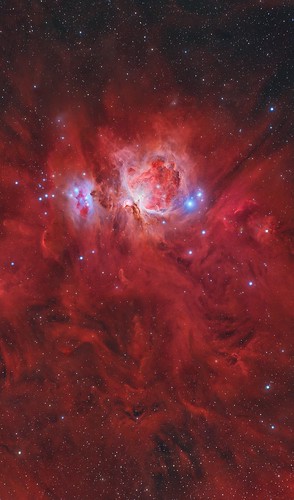 Reprocesado by Raul Villaverde, en Flickr
Reprocesado by Raul Villaverde, en Flickr
 Reprocesado by Raul Villaverde, en Flickr
Reprocesado by Raul Villaverde, en FlickrNGC 1579 North Trifid
Febbraio 2020/Gennaio 2021
Località: San Romualdo - Ravenna
Tecnosky Apo 130 F/6.9
Avalon M1 - QHY5III 174M su OAG Celestron
ASA DDM60PRO con Autoslew e Sequence.
CCD QSI 520wsi raffreddato -20
RGB Astrodon Gen2 I-series
HA-RGB: HA 30x10min, R 31x5min, G 30x5min, B 30x5min
Acquisizione: MaximDL5 - Calibrata con Dark, Bias e Flat.
Elaborazione: MaximDL5, Astroart6, Paint Shop Pro 2021, Topaz e Nik Plug-in.
Cristina Cellini
Località: San Romualdo - Ravenna
Tecnosky Apo 130 F/6.9
Avalon M1 - QHY5III 174M su OAG Celestron
ASA DDM60PRO con Autoslew e Sequence.
CCD QSI 520wsi raffreddato -20
RGB Astrodon Gen2 I-series
HA-RGB: HA 30x10min, R 31x5min, G 30x5min, B 30x5min
Acquisizione: MaximDL5 - Calibrata con Dark, Bias e Flat.
Elaborazione: MaximDL5, Astroart6, Paint Shop Pro 2021, Topaz e Nik Plug-in.
Cristina Cellini
-
fepelle86@gmail.com
- Asternaut
- Posts: 1
- Joined: Wed Jul 22, 2020 10:02 am
Re: Submissions: 2021 January
This project was born with the idea of creating a wide-ranging mosaic of the sword and Orion's belt, the first 3 of 49 panels with four hours of integration for each panel, a job that will require about fifty nights over two years, I wanted to present the first three panels as a wish for the success of my astrophotographic project.
The great Orion nebula is fascinating for its color and quantity of poor interstellars, imagining its distance and seeing the light of 1400 years ago always leaves me speechless.
Shots taken in Valgrana,Cuneo, Italy
Setup: Sw 80 ED heq5 ZWO ASI 533 MC pro.
panel 1: 80x180 sec 21 flat 21 bias 40 dark
panel 2: 80x180 sec - (HDR core M42 5X120 5X60 5X30 5X10
SEC. ) 21 FLAT 21 BIAS 40 dark
panel 3: 80x180 sec 21 flat 21 bias 40 dark
Pixinsight processing. Photoshop.
full resolution: https://i.ibb.co/DM8jpHL/Final-View.png
Credit: Federico Pellegrino
The great Orion nebula is fascinating for its color and quantity of poor interstellars, imagining its distance and seeing the light of 1400 years ago always leaves me speechless.
Shots taken in Valgrana,Cuneo, Italy
Setup: Sw 80 ED heq5 ZWO ASI 533 MC pro.
panel 1: 80x180 sec 21 flat 21 bias 40 dark
panel 2: 80x180 sec - (HDR core M42 5X120 5X60 5X30 5X10
SEC. ) 21 FLAT 21 BIAS 40 dark
panel 3: 80x180 sec 21 flat 21 bias 40 dark
Pixinsight processing. Photoshop.
full resolution: https://i.ibb.co/DM8jpHL/Final-View.png
Credit: Federico Pellegrino
Re: Submissions: 2021 January
HOO Sh2-188 firefox nebula
Copyright : Alan Van
Link to the full Hi-Res image:
https://cdn.astrobin.com/thumbs/L57WPEz ... czOqwr.png
Astrobin details:
https://www.astrobin.com/tpz4sa/?nc=user
Copyright : Alan Van
Link to the full Hi-Res image:
https://cdn.astrobin.com/thumbs/L57WPEz ... czOqwr.png
Astrobin details:
https://www.astrobin.com/tpz4sa/?nc=user
Re: Submissions: 2021 January
Good morning,
I would like to show how astrophotography has changed in the last 10-15 year, achieving results that were impossible even to think 15 years ago.
This is a my shot of the galaxy M82 (NGC3034). As you know M82 is an active galaxy about 12 millions of light years away form us. Previously identified as an irregular galaxy, the near-IR observations done in 2005 found two symmetric spiral arms.
The image was obtained with 30 hours of LRGB exposure plus 100 hours in Hydrogen alpha 3 nanometers to identify better the regions with hydrogen filaments. A careful deconvolution process also on the H-alpha channel permitted to achieve deep fine details.
I wanted to compare my image with the image of the same M82 galaxy but taken by the Hubble Telescope. Of course the HST resolution is much, much higher but considering my telescope is a 180mm from the ground (250 meters above sea level in north of Italy), the result is very good and clearly shows how the new devices and image-processing can now obtain results previously impossible for an amateur astronomer.
M82 comparison with HST
Author: Marco Cosmacini, Villaverde Observatory
Link to my M82 galaxy:
https://flic.kr/p/2ksY2Sb
Regards,
Marco Cosmacini
Italy
I would like to show how astrophotography has changed in the last 10-15 year, achieving results that were impossible even to think 15 years ago.
This is a my shot of the galaxy M82 (NGC3034). As you know M82 is an active galaxy about 12 millions of light years away form us. Previously identified as an irregular galaxy, the near-IR observations done in 2005 found two symmetric spiral arms.
The image was obtained with 30 hours of LRGB exposure plus 100 hours in Hydrogen alpha 3 nanometers to identify better the regions with hydrogen filaments. A careful deconvolution process also on the H-alpha channel permitted to achieve deep fine details.
I wanted to compare my image with the image of the same M82 galaxy but taken by the Hubble Telescope. Of course the HST resolution is much, much higher but considering my telescope is a 180mm from the ground (250 meters above sea level in north of Italy), the result is very good and clearly shows how the new devices and image-processing can now obtain results previously impossible for an amateur astronomer.
M82 comparison with HST
Author: Marco Cosmacini, Villaverde Observatory
Link to my M82 galaxy:
https://flic.kr/p/2ksY2Sb
Regards,
Marco Cosmacini
Italy
Last edited by bystander on Sun Jan 24, 2021 3:30 pm, edited 1 time in total.
Reason: All <img> tags require an image url not a page url.
Reason: All <img> tags require an image url not a page url.
Re: Submissions: 2021 January
A reprocessing of SH2-115 - Wide Field
Click on above to expand.
Full info @ https://www.kinchastro.com/sh2-115.html
Click on above to expand.
Full info @ https://www.kinchastro.com/sh2-115.html
-
jaspalchadha
- Ensign
- Posts: 52
- Joined: Tue Jun 09, 2015 10:23 am
- Location: England
- Contact:
-
lucam_astro
- Asternaut
- Posts: 9
- Joined: Sun Sep 01, 2019 3:10 am
Re: Submissions: 2021 January
Heckathorn-Fesen-Gull 1 (HFG1, PK136+05) is a very old (~100,000 year old) and extremely faint planetary nebula in the constellation Cassiopeia. It was discovered in deep OIII images by Heckathorn, Fesen, and Gull in 1982 using the emission line survey of Parker et al (1979). The central star is a binary variable pair V664 Cas (13.7 magnitude). HFG1 is the first well observed PN, which reveals a cometary-like structure. As HFG1 moves through the interstellar medium and V664 ejects material, a bluish bow shock is formed and a red long trail of emissions is left in its wake.
Acquisition details:
https://astrob.in/tbilkr/0/
TS ONTC 10in f4
TeleVue Paracorr Type 2
ZWO ASI1600MM Pro, ASI294MM Pro
Astrodon 3nm Ha, 3nm OIII, RGB filters
AP 1100GTO
Data acquired in Schenectady, NY from September 2020 to January 2021
Total integration time: 82 hours.
Copyright: Luca Marinelli 2021
Acquisition details:
https://astrob.in/tbilkr/0/
TS ONTC 10in f4
TeleVue Paracorr Type 2
ZWO ASI1600MM Pro, ASI294MM Pro
Astrodon 3nm Ha, 3nm OIII, RGB filters
AP 1100GTO
Data acquired in Schenectady, NY from September 2020 to January 2021
Total integration time: 82 hours.
Copyright: Luca Marinelli 2021
-
barretosmed
- Science Officer
- Posts: 482
- Joined: Thu Oct 12, 2017 6:04 pm
Re: Submissions: 2021 January
The Grus Quartet (Galaxy) (NGC 7552, 7582, 7590, 7599)
Located in the Grus Constellation, are all 4 spiral galaxies.
Further up we have NGC 7552, the smallest of the three below is ngc 7590, with its mate next to ngc 7599. The most central and most studied of them is NGC 7582.
NGC 7582 is a type 2 Seyfert galaxy, such a classification is due to the fact that the galaxy has an extremely bright supermassive central black hole very similar to a quasar (most energetic objects in the universe). The black hole of NGC7582 is about 10 million times the mass of our sun.
Best details:
https://www.astrobin.com/full/734y09/0/
Equipment:
Apo 150mm triplet
Qhy 16200
15 L 500 "
43 RGB 300 "
Processing and Capture:
Software: PixInsight, Adobe Photoshop, APT, PHD, Polemaster, Sharcap
07/27/2019
Munhoz - MG - Brazil
Copyright: Fernando Oliveira de Menezes
Email: Barretosmed@hotmail.com
Located in the Grus Constellation, are all 4 spiral galaxies.
Further up we have NGC 7552, the smallest of the three below is ngc 7590, with its mate next to ngc 7599. The most central and most studied of them is NGC 7582.
NGC 7582 is a type 2 Seyfert galaxy, such a classification is due to the fact that the galaxy has an extremely bright supermassive central black hole very similar to a quasar (most energetic objects in the universe). The black hole of NGC7582 is about 10 million times the mass of our sun.
Best details:
https://www.astrobin.com/full/734y09/0/
Equipment:
Apo 150mm triplet
Qhy 16200
15 L 500 "
43 RGB 300 "
Processing and Capture:
Software: PixInsight, Adobe Photoshop, APT, PHD, Polemaster, Sharcap
07/27/2019
Munhoz - MG - Brazil
Copyright: Fernando Oliveira de Menezes
Email: Barretosmed@hotmail.com
-
pincushion
- Asternaut
- Posts: 1
- Joined: Wed Jan 13, 2021 9:48 pm
Re: Submissions: 2021 January
The Tarantula Nebula
Located in the LMC deep in the southern skies we have this amazing star nursery
Equipment
Skywatcher AZ-EQ6
Sharpstar AL140PH Refractor
Chroma 3nm filters (Ha, SII, OIII, NII)
Ha 19 x 300s
SII 21 x 300s
OIII 21 x 300s
Captured using N.I.N.A
Processed in PixInsight
Captured from Bortle 7/8 Randwick, Australia - 11 January 2021
barryfrombondi@gmail.com
Located in the LMC deep in the southern skies we have this amazing star nursery
Equipment
Skywatcher AZ-EQ6
Sharpstar AL140PH Refractor
Chroma 3nm filters (Ha, SII, OIII, NII)
Ha 19 x 300s
SII 21 x 300s
OIII 21 x 300s
Captured using N.I.N.A
Processed in PixInsight
Captured from Bortle 7/8 Randwick, Australia - 11 January 2021
barryfrombondi@gmail.com
-
mdieterich
- Science Officer
- Posts: 100
- Joined: Fri Feb 13, 2015 5:50 pm
Re: Submissions: 2021 January
Winter Milky Way Deep Sky Objects
www.mattdieterich.com
Copyright: Matt Dieterich
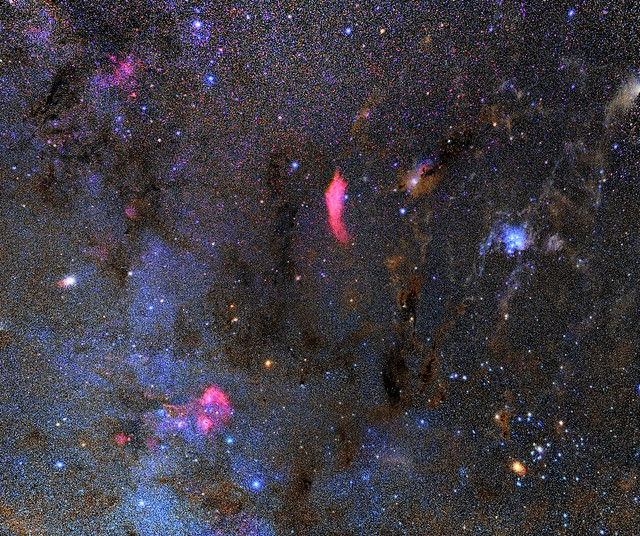
https://live.staticflickr.com/65535/508 ... c973_b.jpg
www.mattdieterich.com
Copyright: Matt Dieterich

https://live.staticflickr.com/65535/508 ... c973_b.jpg
Last edited by bystander on Mon Jan 25, 2021 5:43 am, edited 2 times in total.
Reason: Please, no hot links to images > 500KB. Substituted smaller image,
Reason: Please, no hot links to images > 500KB. Substituted smaller image,
-
Daniel DeSclafani
- Ensign
- Posts: 13
- Joined: Fri Oct 16, 2020 12:33 am
-
mdieterich
- Science Officer
- Posts: 100
- Joined: Fri Feb 13, 2015 5:50 pm
Re: Submissions: 2021 January
Craters of the Moon National Monument Milky Way
www.MattDieterich.com
Copyright: Matt Dieterich Capturing large panorama shots like this one are a lot of fun to showcase just how stunning the night sky is from our National Parks. I set out to capture the highest resolution panorama ever captured from Craters of the Moon National Monument in Idaho and I think I achieved that feat with this 77 panel image. The original image was so large it contained over 1 billion individual pixels. If you ever get the chance to explore Southern Idaho I highly recommend the trip. (Modified Nikon Z6 10 second exposures ISO 10,000 at F1.4).
www.MattDieterich.com
Copyright: Matt Dieterich Capturing large panorama shots like this one are a lot of fun to showcase just how stunning the night sky is from our National Parks. I set out to capture the highest resolution panorama ever captured from Craters of the Moon National Monument in Idaho and I think I achieved that feat with this 77 panel image. The original image was so large it contained over 1 billion individual pixels. If you ever get the chance to explore Southern Idaho I highly recommend the trip. (Modified Nikon Z6 10 second exposures ISO 10,000 at F1.4).
-
barretosmed
- Science Officer
- Posts: 482
- Joined: Thu Oct 12, 2017 6:04 pm
Re: Submissions: 2021 January
SNAKE NEBULA, THE BLACK SNAKE IN THE SPACE
BEST DETAILS AND QUALITY
https://www.astrobin.com/full/p9gruu/B/?nc=user
Dark nebulae are a show apart, some visible with the naked eye in places with low light pollution, these regions are a type of interstellar cloud so dense that it obscures the starlight in the background.
Dark clouds appear like this due to micrometric dust particles, coated with carbon monoxide and frozen nitrogen, which effectively blocks the passage of light at visible wavelengths.
THESE DUST MOLECULAR CLOUDS PROBABLY CONTAIN SUFFICIENT RAW MATERIALS TO FORM HUNDREDS OF THOUSANDS OF STARS
Equipment:
Apo ESPRIT 150mm
New asi 6200mc
50 x 100seg
Cem60 mount
07/23/2020
Munhoz- MG- Brazil
Processing and capture:
Software: Pixinsight , Adobe Photoshop, Sequence generation pro, PHD, Polemaster, SharpCap
Copyright: Fernando Oliveira de Menezes
Email: Barretosmed@hotmail.com
BEST DETAILS AND QUALITY
https://www.astrobin.com/full/p9gruu/B/?nc=user
Dark nebulae are a show apart, some visible with the naked eye in places with low light pollution, these regions are a type of interstellar cloud so dense that it obscures the starlight in the background.
Dark clouds appear like this due to micrometric dust particles, coated with carbon monoxide and frozen nitrogen, which effectively blocks the passage of light at visible wavelengths.
THESE DUST MOLECULAR CLOUDS PROBABLY CONTAIN SUFFICIENT RAW MATERIALS TO FORM HUNDREDS OF THOUSANDS OF STARS
Equipment:
Apo ESPRIT 150mm
New asi 6200mc
50 x 100seg
Cem60 mount
07/23/2020
Munhoz- MG- Brazil
Processing and capture:
Software: Pixinsight , Adobe Photoshop, Sequence generation pro, PHD, Polemaster, SharpCap
Copyright: Fernando Oliveira de Menezes
Email: Barretosmed@hotmail.com








